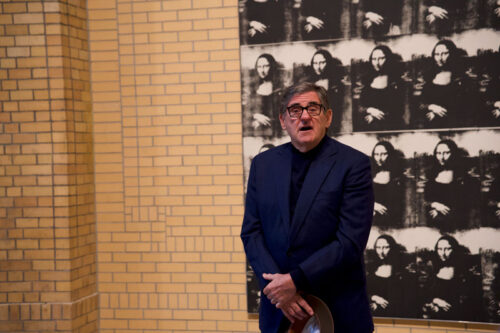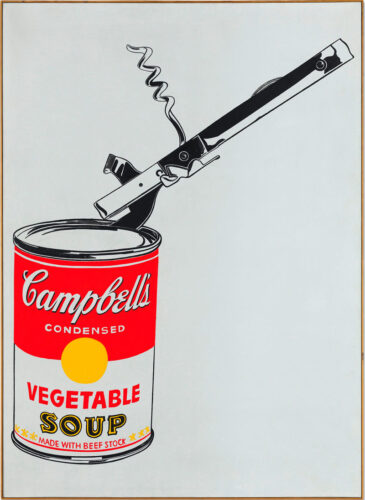You know how they say you always remember your first? Well Peter M. Brant, the globally important collector of contemporary art and long-time pal of pop art godfather Andy Warhol, certainly remembers his.
“The first piece I bought is that drawing right there of a stack of soup cans. I bought it in 1967,” he said the other day while standing among some of the many Warhol works he has accumulated since the purchase of that early soup can study. There were Marilyns and Maos, shoes and skulls, Dick Tracey and Liz Taytor and of course various Campbell’s soup cans and a box of Brillo.
The Brant Foundation’s new exhibit, which opens to the public on May 10 at the foundation’s East Village location at 421 East 6th Street, features dozens of Warhol works drawn largely from Brant’s rarely-seen personal collection, one of the world’s most comprehensive. The show is a snapshot of the pop art patriarch’s oeuvre, capturing the diversity and the evolution of his visual art stylings over a career that spanned nearly four decades. It includes drawings, paintings, silk screen prints, sculptures and polaroids.
The show is titled Thirty Are Better Than One, after the 10-foot-tall silkscreen featuring 30 identical images of the Mona Lisa that dominates one wall of the three-floor exhibit. While the exhibition ably traces Warhol’s illustrious career, it likewise follows Brant’s remarkable career as a collector.
“Some of this work that you see here was collected at a time when I was a teenager and some of it as recently as a few months ago. So it embodies a long period of time,” Brant said standing before the giant, eponymous Mona Lisa piece and the much smaller, but far more colorful, Dick Tracy (1961), an acrylic and wax crayon work.
Among the other works included in this striking and compelling exhibition are two special pieces Brant acquired as a novice collector seeking to leverage a windfall he got from a wise stock market investment. His purchase of Campbell’s Soup Can (Chicken with Rice) (1962) and Shot Light Blue Marilyn (1964) also turned out to be wise investments. A sister piece to Brant’s Marilyn, the iconic Shot Sage Blue Marilyn, sold last year at Christie’s for $195 million, the most expensive 20th century artwork ever to sell at auction. The buyer, incidentally, was uber-gallerist Larry Gagosian.
Among the many other important Warhol works on display at Thirty Are Better are a pair of early works that marked critical junctures in the evolution of the artist and in the history of art itself. Of course every piece in the show is a VIP, but some are VVIPs.
In White Disaster (White Car Crash 19 Times) (1963), a 12-by-6-foot work made up of 19 identical silk screen images of a horrific car crash that occurred on the New Jersey Turnpike, you can see the pop art beacon alight.
Viewers are made small by the grand scale of the towering pop art taproot, which confronts you again and again with grainy black-and-white images of tragedy and death in the modern world. The photograph Warhol used to make White Disaster, part of his “Death and Disaster” series, was originally published by Newsweek.
Sotheby’s called the work “a monumental altarpiece for the modern age” adding that it “stands amongst the most radical and haunting artistic achievements of the 20th century.” The piece was auctioned off last year to a then anonymous buyer for $85.4 million. That buyer, we now know, was Brant.
The second critically important piece on display is Big Campbell’s Soup Can With Can Opener (Vegetable) (1962), which Brant acquired at auction in 2017. The painting was the first to introduce the iconic soup can to Warhol’s oeuvre. It also introduced Warhol and pop art to the masses in a Time magazine spread.
The piece – from “a series that changed the face of 20th-century art,” according to Christie’s – shows the can opener just about to pierce the can’s top. The other works in the 11-piece series show the can’s top being wrenched open.
Can With Can Opener marks the early days of Warhol’s obsession with the quotidian objects of daily life in 1960s America, his fascination with consumerism and ubiquitous branding, and his way of at once celebrating and denouncing banal commercialization. The piece was last seen in New York as part of “Andy Warhol: A Retrospective” at MoMA in 1989.
Other noteworthy pieces from the show: Pin the Tail on The Donkey (1953), a colorful folding screen created for a Tiffany’s window; Elvis Presley (Gold Boot) (1956), one of pieces depicting celebrity shoes using gold leaf and collage; and Mae West (1956), a fantastical copper leaf appliqué imagining the actress’s shoe.
The East Village is an appropriate locale for a Warhol show, given the artist’s long association with the neighborhood and its storied art history. Warhol’s Electric Circus, the short-live discotheque where the Velvet Underground performed as part of a multimedia experience known as the “Exploding Plastic Inevitable” opened in 1967 just a few blocks from the Brant Gallery. Warhol owned the building on nearby Great Jones St. where Jean-Michel Basquat lived, worked and ultimately died. And Warhol’s Union Square Factory and hang-out Max’s Kansas City also were close.
Brant has a shorter, though already distinguished history in the neighborhood. The Brant Foundation acquired the E. 6th St. location, which features 7,000 square feet of exhibit space, in 2014 for $27 million. Originally designed as a substation for ConEd, the building was home and studio of famed artist Walter De Maria from the mid-1980s until his death in 2013. De Maria, by the way, was in a band called The Primitives, with Lou Reed and John Cale before the latter two went on to form the Velvet Underground and collaborate with Warhol.
Brant inaugurated the space in 2019 with an amazing exhibition of works by Basquiat, also largely drawn from his personal collection. This latest show comes as Brant is about to sell Basquiate’s Now’s the Time at Sotheby’s with a guarantee price of $30 million.
“There’s a long history of art in this neighborhood going back to the American impressionists…so it just happened,” Brant said of his move into the East Village.
The work of Warhol, who died of cardiac arrhythmia at 58 in 1987, has hardly lost its luster and, in fact, continues to gain both value and momentum in the collector world. Last year, according to artprice.com, Warhol was the world’s top-selling artist with a total of $590 million. Some 2,100 Warhol’s sold at auction in 2022, more than everyone except Pablo Picasso, with 3,400 works, and Salvador Dali, with 2,500.
Thirty are Better Than One is open Wednesday through Friday 11 a.m. to 6 p.m., Saturday and Sundays 11 a.m. to 5:30 p.m. and runs through July 30. Tickets are available at brantfoundation.org.




